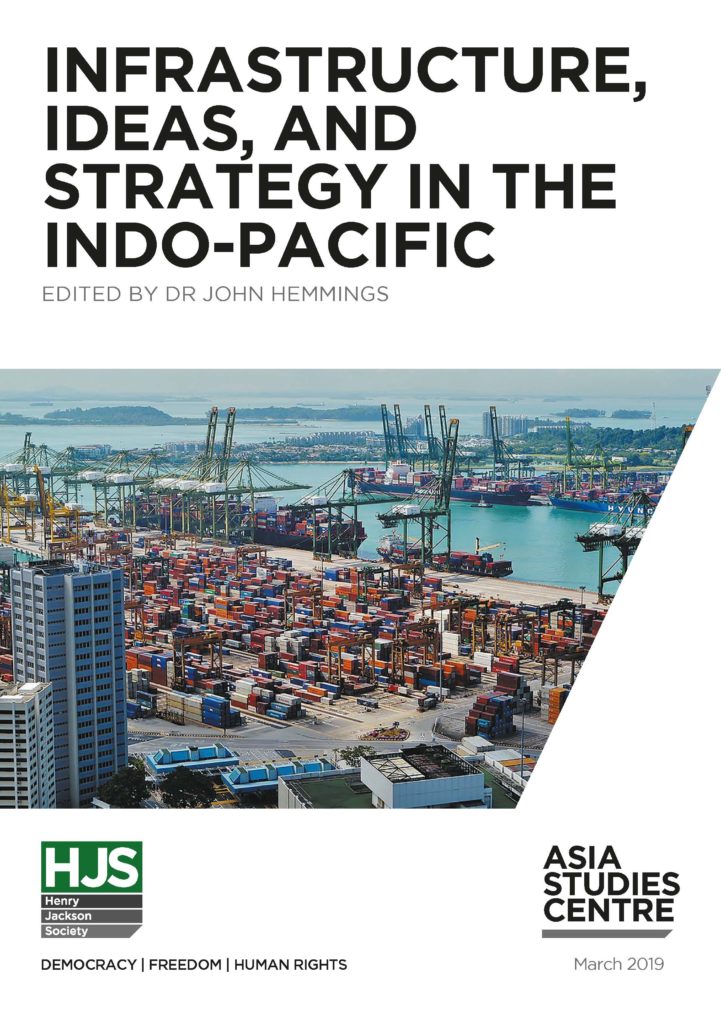SHOP
Infrastructure, Ideas, and Strategy in the Indo-Pacific

"These essays on the Indo-Pacific could not be appearing at a better time." Rt Hon. Sir Malcolm Rifkind, Former Foreign Secretary, Former Defence Secretary
An expert panel of scholars have authored a series of eight essays released as “Infrastructure, Ideas, and Strategy in the Indo-Pacific”, a report by the Henry Jackson Society. The essays explore the concept of the ‘Indo-Pacific’ and its ramifications for geostrategic thinking. The report also explores the role or prospective role of the UK in the Indo-Pacific in an essay authored by David Scott.
The report’s key findings include:
- The Indo-Pacific is rapidly becoming the centre of the world’s economy.
- By 2050, it will account for over half of global GDP and become a fulcrum point between old and new powers, for deciding regional architecture.
- The Indo-Pacific is the place where the future of global power – and hence global order – will be decided.
- This economic growth has enmeshed the Indo-Pacific in emerging geopolitical and maritime rivalries, reviving “Mahanian” approaches toward sea-power: states are now modernising their naval power to secure those sea lanes crucial to their national security.
- Infrastructure, particularly ports, play both a security and economic role in the Indo-Pacific.
The first chapter, written by Dr Kun-Chin Lin from Cambridge University, looks at how China’s strategic approach towards sea lane security, container shipping trends, and port development has become a proxy for geopolitical manoeuvring and, as a result, has framed much of the discussion. The second chapter examines Japan’s role in the creation of the Indo-Pacific and its infrastructure strategy. pan’s role in the creation of the Indo-Pacific and its infrastructure strategy. To some extent, in this latter capability, Dr Kei Koga, from Nanyang Technological University (NTU), shows how Japan has been the fastest mover in this area, highlighting a hitherto unknown Japanese assertiveness. This leads into the third chapter, by Professor Rahul Roy-Chaudhuri explores India’s strategic understanding of the Indo-Pacific concept, examining both its origins as well as its evolution. The fourth chapter, by Professor Harsh Pant, from the Observer Reach Foundation (ORF) in New Delhi, which examines how infrastructure and investment feed into India’s overarching grand strategy.
The fifth chapter, written by Dr Euan Graham, of La Trobe Asia, examines how Australia has attempted to rationalise the Indo-Pacific concept across the various aspects of its foreign and economic policy bureaucracy in order to deal with the intersection between trade and geopolitical leverage. The sixth chapter, by Ian Easton from Project 2049 Institute, examines how the US’ late arrival to the concept – during a major shift in its relationship with China – has produced an infrastructure strategy that perhaps the most overtly characterised by geopolitical competition. He also notes how the US – with its vast foreign policy machine and alliance-management history – has become an organising point for the other powers. In the seventh chapter, David Scott lays out Britain’s take on the Indo-Pacific and sketches out some early indicators of directions London might pursue as Brexit fades from memory. In the eighth chapter, Dr Satoru Nagao, from the Hudson Institute, provides a robust declaration of intent on how Quad members should tackle what he sees as China’s global ambitions, in BRI and the Maritime Silk Road.
The issues explored within the report could not be more timely, at a roundtable in December 2018, the Asian Development Bank (ADB)reported the Indo-Pacific region would need an estimated £1.29 trillion every year until 2030 in infrastructure investment to support growth and meet the regional infrastructure challenges posed by climate change. The ADB identified a funding gap of around £567 billion a year beyond what countries and institutions are currently investing in regional infrastructure.
China’s much-vaunted “Belt and Road Initiative” (BRI) – a grand strategic narrative that ties together commerce, infrastructure development and geopolitical power – helps close that funding gap. But its use of debt-diplomacy to gain control of ports as collateral looks increasingly geostrategic. There is now a growing business and geostrategic case for the UK to collaborate with other regional powers to provide alternatives to the Chinese model.
These eight essays explore how other states view the Indo-Pacific concept and what geo-economic role they envision it containing. The concept of the ‘Indo-Pacific’ is more than just a competing strategy: it is a framework or policy basket that seeks to explain and influence the changing geopolitical patterns, interests and powers across the region and beyond.
English
64
Price:
£9.95
(Inc. UK P&P)


